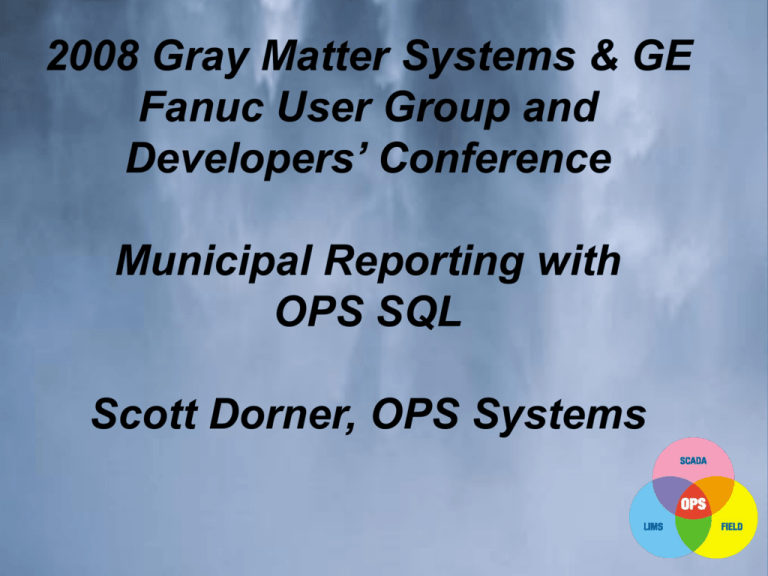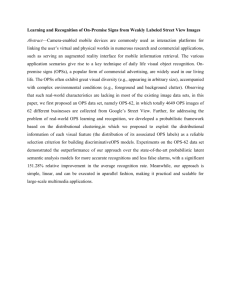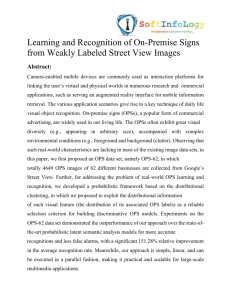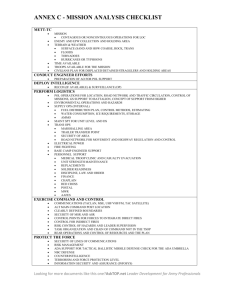2008_Gray_Matter_User_Conf
advertisement

2008 Gray Matter Systems & GE Fanuc User Group and Developers’ Conference Municipal Reporting with OPS SQL Scott Dorner, OPS Systems OPS SYSTEMS We are a Commercial Off The Shelf Software developer and implementer for the Water & Wastewater Industry Industry experts with 8 programmers, 3 chemists, licensed operator, PE… We have over 2000 water/wastewater customers and have been in business for 30 plus years. The clutter of data In your home, the accumulation of “stuff” makes it difficult to find anything. At the plant, the accumulation of data makes it difficult to find answers. Why do we collect it SCADA – Detailed Historical record of what happened LAB/LIMS – Detailed record of how results were achieved, audits. Operations – To verify plant is in control and operators are paying attention Calculations – Cause we have to for regulatory reports LIMS Laboratory Information Management System • • Used by commercial Labs and Medium to large plant labs • Most small plants use paper system and Excel LIMS • Sample Scheduling • Sample Login and Tracking (Chain of Custody) • Enter/Verify Results • Report Results • Instrument Interfacing • QC Analysis Review samples in your lab LIMS • Aspen by Telecation • Labworks by Perkin Elmer • Lab Cal by OPS Systems • Tribal • LabVantage • Many more Separate systems create the islands of Excel SCADA – Produces reports via Excel LAB – LIMS produces COA and COC reports that are printed, faxed, emailed. Operations – Paper and Excel forms Regulatory Reporting is a scramble. Usually one gatekeeper who roles it all together into Excel. Spreadsheet nightmares Easy to start and make progress quickly on a problem. Over time it evolves into a cross linked monster with hidden columns, macros, etc… Different Views: Each department has it’s “own” copy of the data. Same data entered many times instead of imported directly from the source Not a database, no audit, multiuser capability Spreadsheet nightmares Where did this number come from? Who changed my number? Why is this number different in this report? Am I liable for errors in regulatory reports? 11 Spreadsheet nightmares Typically only one person knows how to keep it alive. Studies show this is typically a high paid analyst who spends up to 2.5 days/week managing the spreadsheet. “Instead of analyzing data, these high-priced employees act like surrogate information systems professionals, gathering, massaging, and integrating data. “ - TDWI Best practices report: Strategies for managing spreadmarts by Wayne Eckerson and Richard Sherman Hidden Cost: With average salary of the analyst at 65K and several spreadsheets in an organization cost quickly add up. - Best Practices for your information management provider, Barry Liner, AEM Portland, ME General belief that the data was in SCADA: Review of monthly reports revealed: 13 to 20% Continuous process data (SCADA) 20 to 30% from the Lab (Manually entered) 20 to 30% Manual entry (process by operators) 25% Calculations (combination of the above) <3% Other sources Many of these sources were “unsecured” “I want to spend time analyzing information, not formatting and collecting data.” – Scott Firmin, Portland Water District, creator of “Giant Sheet” Existing System 7.28 7.28 7.82 7.82 OPS SQL – The power of information Data Management Software for Water and Wastewater Systems Combines SCADA, Lab, and operator log data and performs calculations on the data Reports and charts turn the raw data into information Integration with iFix 5.0 (and 4.5) as part of the Water Solutions Pack 2008. OPS SQL – The power of information How does it work Data is automatically transferred from SCADA/Historian and LIMS systems Data can also be entered through OPS data entry forms, PDAs, or Tablet PCs. From the central location you can run calculations and analysis. Allowing you to easily produce… 1. Accurate regulatory reports 2. Graphs / Analysis OPS SQL – The power of information Saves Time •Data is automatically transferred from SCADA/Historian and LIMS systems •Easy to Use • Designed for operators. • Data entry forms can be designed to look just like your paper forms. • Templates for regulatory reports such as SWTR, NPDES, DMRs… • Your people can design reports, forms and graphs • Data at your fingertips • Reports and Analysis is readily available to the people who need it • Accurate regulatory reports including eDMRs, SWTR Reports, NPDES, OH4500. • No more unsecured spread sheets, islands of data, duplicate entries OPS SQL – The power of information Powerful • Over 100 Industry specific calculations including Loadings, Dosages, CT Ratio, Percentiles, Geometric Means, SWTR compliance • Properly handles data qualifiers (<,>, TNTC) in calculations such as weekly averages, loadings, etc… according to your rules • Track your permit and QC limits • Schedule printing/emailing of reports and graphs OPS SQL – The power of information Peace of mind •Data is stored in standard databases such as Microsoft SQL Server, Oracle or MSDE. • All data is audited. You will know who and when data was entered, edited, deleted. • Data Approval can be used to further secure the data. Once privileged users approve the data only they can edit it. • Operations 1800 WTP & WWTP • LIMS 150 WTP, WWTP & enviro. Labs • Maintenance 800 WTP & WWTP 20 DEMO Questions? Scott Dorner, Product Manager OPS Systems spd@opssys.com www.opssys.com 800-677-0067 http://www.opssys.com/instantkb/article.aspx?id=11483





